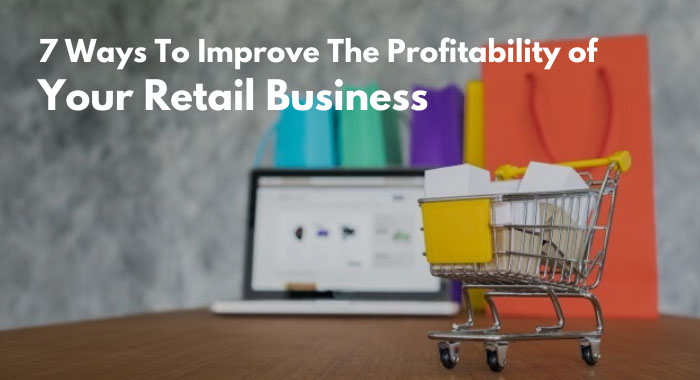All retailers have the same goal: boost sales while reducing expenses in order to save money, improve profitability, and grow their business. But even though the goals might be the same, how each retailer will achieve this will vary.
However, some steps that can help you make your business more successful are universal and, what’s more important, quite simple.
Take a look at these 7 ways to improve the profitability of your retail business.

1. Find New Sales Opportunities
Retailers should always be on alert for new selling opportunities. Whether it is planning an expansion into a multi-channel environment, up-selling to a customer, collaborating with influencers, leveling up your online game, or something entirely different, you need to be ready to take advantage of every single sales opportunity that comes your way.
2. Put an Emphasis on Marketing
Have you been postponing the launch of your first marketing campaign? You might be convinced that you just can’t afford to advertise your business at the moment or that it would be better to wait until you’ve made some sales, but the truth is you could be losing lots of potential customers. After all, how do you expect people to know about your business if you don't spread the word?
Using the right marketing techniques can help you turn any slums in sales around and get you back on track with your goals. After all, not all marketing tactics require a huge budget. For instance, you can use SEO to increase your online visibility or social media to promote your merchandise (just make sure to tailor your marketing to your target audience).
3. Rely on Data
Data analytics has become one of the most critical details required to help businesses grow and improve. Its application in various industries ranges from discovering fresh sales opportunities to identifying operational inefficiencies.
Data analytics has been disrupting retail for a while now, an industry where the competition is especially fierce. By leveraging valuable insights, retailers can deliver more focused goods, better-targeted promotions, and open new opportunities for growth.
PostgreSQL is an open-source database chosen by many businesses for numerous
data operation requirements and one that can be implemented across various environments. Still, not many people are familiar with the use of Postgres as a data warehouse.
Many companies use Postgres as ETL. Extract, Transform and Load (ETL) is a 3-step process of extracting data from different sources, filtering it in accordance with a business’ requirements, and loading it into a database for the purpose of conducting analytics.
4. Add New Products & Remove the Unprofitable Ones
One way to boost your profitability is to keep customers returning to your store. And what better way to achieve this than by offering new & exciting products (or even product lines)?
But when you make a decision to add new products or expand product lines, bear in mind that there should be a demand for such items. In addition, it should be something you enjoy selling and, of course, bring you profits.
On the other hand, you need to consider removing any products that are unprofitable. Start by identifying the products with the highest gross profit margin. These are the most important to your business and that’s where your focus should be. Then, determine whether the unprofitable products should be reviewed for areas of improvement or removed altogether.
5. Lower Your Expenses
In order to improve your business and increase your profits, you need to learn how to cut your operating expenses.
Start by looking around your store. Would buying pay off more than leasing? Are there any tasks outsourced tasks you could be doing yourself?
You should also consider reducing your direct costs. One way to do this is to negotiate discounts or better prices for everything you buy. This might mean finding a new supplier, and even though the very idea may sound daunting, it’s definitely worth giving a shot.
Another way to reduce your overall direct costs is to eliminate overspending. Review your direct costs to identify any areas where unnecessary purchases have occurred.
Finally, reduce your overhead expenses. Believe it or not, overheads have a way of growing over time without us noticing it. One very simple but effective way to improve your profit is to review your overheads regularly. Compare your business to other retail businesses to identify areas that need improvement.
6. Improve Customer Service
There’s a number of things that can impact customer experiences, like products, store environment, and prices, but customer service is definitely one of the most important factors that affect how people perceive your brand.
And while there are certain things you can’t influence, like controlling your competitors, providing top-notch service is entirely up to you. For that reason, you should always be thinking about how to wow your customers.
Great customer service means building connections with customers, meeting their needs in an efficient, pleasant, and timely way, appreciating repeat customers, putting your product knowledge to good use, etc. In retail, it could also mean directing shoppers to the right part of the store or helping them with a product issue.
7. Hire a Business Coach

Even if you are doing everything right as a retailer, there can be times when you need renewed focus, support, and clarity. Enter: business coaching.
Just like athletes need coaches in order to achieve their goals and become more successful, retailers also need someone who acts as your guide on the side. A business coach is someone who has your best interest at heart, who recognizes what your natural weaknesses and strengths are, and will offer an objective view of what works well.
Final Words
Making your retail business more profitable involves implementing different ideas that will help you boost sales revenue while at the same time decreasing costs. Get these 7 tips right and you are bound to see great results, in sales and your business overall.

Author Bio: Igor Zagradanin
Igor is a content marketing expert with a proven track record of helping businesses by adding value to their brands, developing a content marketing strategies, as well as educating and connecting with their audiences on a personal level. In his spare time, he plays guitar, produces electronic music, does yoga, learns how to ski, and (with more or less success) tries to get in touch with his inner child.
